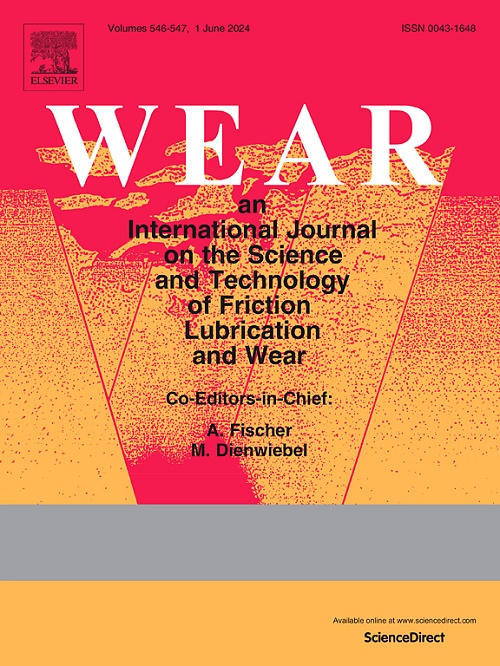Investigation of the chemical structure and antiwear performance of biochar used as a grease additive
IF 5.3
1区 工程技术
Q1 ENGINEERING, MECHANICAL
引用次数: 0
Abstract
The aim of the work was to investigate the influence of the microstructure of biochar additives on the antiwear performance of lithium greases. The novelty of this work is the investigation of the possibilities of effectively replacing the critical raw material (graphite), used as an anti-wear additive to greases, with biochar derived from agricultural waste and to study the impact of biochar on the friction surface. The initial grease based on paraffin oil and lithium stearate and four greases additionally enriched with 3 wt% or 5 wt% of biochar produced during the pyrolysis of flax or wheat biomass were tested. All the greases had an NLGI grade of 2. The biochar additives were examined using FTIR, and the ID/IG ratio was determined based on Raman spectra. Friction tests were carried out in a roller-block system made of 100Cr6 bearing steel. After the tests, the volumetric wear of the blocks was determined using a profilometer and the chemical structure of the friction surfaces was examined using SEM/EDS and XPS. The research has confirmed that a higher content of biochar in the grease reduces the volumetric wear of the blocks more effectively. The best tribological properties were demonstrated by the grease containing 5 wt% of flax biochar, which resulted in a 24 % reduction of wear compared to the wear of the block lubricated with the model grease. It was found that additives with more highly ordered graphite structures (ID/IG = 0.33) and without oxygen functional groups showed better antiwear performance than biochar additives containing such groups but with a more disordered structures (ID/IG = 0.44). The wear tracks included iron oxides and thin layers of greases that were not removed when the blocks were ultrasonic cleaned after the tests. Further analysis will allow to determine the mechanism of boundary layer formation. Then researchers will be able to present the results in a subsequent paper.
生物炭作为油脂添加剂的化学结构及抗磨性能研究
研究了生物炭添加剂的微观结构对锂脂抗磨性能的影响。这项工作的新颖之处在于,研究了用来自农业废弃物的生物炭有效替代润滑脂中用作抗磨添加剂的关键原料(石墨)的可能性,并研究了生物炭对摩擦表面的影响。测试了以石蜡油和硬脂酸锂为基础的初始油脂,以及另外添加了亚麻或小麦生物质热解过程中产生的3 wt%或5 wt%生物炭的4种油脂。所有润滑脂的NLGI等级均为2。利用FTIR对生物炭添加剂进行检测,并利用拉曼光谱测定其ID/IG比。在100Cr6轴承钢滚轮滑块系统中进行了摩擦试验。试验结束后,用轮廓仪测定了块体的体积磨损,用SEM/EDS和XPS检测了摩擦表面的化学结构。研究证实,润滑脂中较高含量的生物炭可以更有效地减少块体的体积磨损。含有5%亚麻生物炭的润滑脂具有最佳的摩擦学性能,与使用模型润滑脂润滑的块相比,其磨损减少了24%。结果表明,石墨结构高度有序(ID/IG = 0.33)且不含氧官能团的添加剂的抗磨性能优于含氧官能团但结构无序(ID/IG = 0.44)的生物炭添加剂。磨损痕迹包括氧化铁和薄层的油脂,在测试后用超声波清洗时,这些油脂并没有被去除。进一步的分析将有助于确定边界层形成的机制。然后,研究人员将能够在随后的论文中展示结果。
本文章由计算机程序翻译,如有差异,请以英文原文为准。
求助全文
约1分钟内获得全文
求助全文
来源期刊

Wear
工程技术-材料科学:综合
CiteScore
8.80
自引率
8.00%
发文量
280
审稿时长
47 days
期刊介绍:
Wear journal is dedicated to the advancement of basic and applied knowledge concerning the nature of wear of materials. Broadly, topics of interest range from development of fundamental understanding of the mechanisms of wear to innovative solutions to practical engineering problems. Authors of experimental studies are expected to comment on the repeatability of the data, and whenever possible, conduct multiple measurements under similar testing conditions. Further, Wear embraces the highest standards of professional ethics, and the detection of matching content, either in written or graphical form, from other publications by the current authors or by others, may result in rejection.
 求助内容:
求助内容: 应助结果提醒方式:
应助结果提醒方式:


